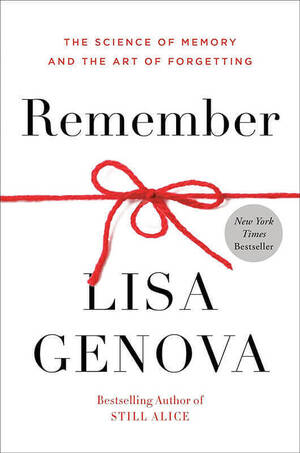My mother was a storyteller. She memorized moments of her life the way actors do Shakespeare. There was that Christmas during hard times. She expected a china doll. Heartbroken, she got an orange and a game of pick-up sticks. She loved to share how she and my father, a young Navy officer, married just days before Pearl Harbor. She told stories of my brother’s legendary finickiness and the time I injured my eye. My childhood was far richer thanks to her memory.
She told some tales so often I knew them by heart. They were always the same. Then one day they weren’t. Dramatic pauses vanished. Punchlines got mangled. Details went missing.

Something was wrong. My mother had Alzheimer’s disease.
These days not even cancer is as dreaded as a dementia diagnosis. Though new drugs can delay the malady’s progress, nothing to me is as frightening as the thought of losing my . . . self.
No wonder I enjoyed Lisa Genova’s novel Still Alice, the story of a 50-year-old Harvard professor with early-onset Alzheimer’s. The book became a 2015 movie of the same name and won a Best Actress Oscar for its star, Julianne Moore.
Genova is a neuroscientist. Her book Remember: The Science of Memory and the Art of Forgetting is, well, memorable, especially if you, like me, are middle-aged or older.
Here is how she describes memory in all its glorious unreliability: “In the process of consolidating an episodic memory, your brain is like a sticky-fingered, madcap chef,” she writes. “While it stirs together the ingredients of what you noticed for any particular memory, the recipe can change, often dramatically, with additions and subtractions supplied by imagination, opinion, or assumptions. The recipe can also be warped by a dream, something you read or heard, a movie, a photograph, an association, your emotional state, someone else’s memory, or even mere suggestion.”
In short, says Genova, “Resign yourself to never fully knowing the truth of what actually happened.”
That’s why, according to her and to legal experts, one should doubt eyewitness testimony in court. It is wildly unreliable. Of the hundreds of innocent people whose convictions were overturned thanks to DNA evidence since 2019, three-fourths of them, Genova reports, had been found guilty based on what eyewitnesses swore they had seen.
Memory is weird. Shakespeare in Macbeth called it “the warder of the brain.” For something that’s supposed to be like a prison warden or gamekeeper, our minds’ storage mechanisms sure let a lot of wonderful geese fly off while locking in things best forgotten.
What we remember is scattered in our brains. Genova explains how memories go through a three-stage creation process — encoding, consolidation, storage — that always involves the hippocampus, a seahorse-shaped body deep in the skull. For every memory, the mind’s neurons (nerve cells) weave a new network which is fixed in place. Sight memories go where vision is processed, smell memories where scents are deciphered, and so forth.
Alzheimer’s begins in the hippocampus. Most researchers believe a rogue protein called beta amyloid gums up gaps between synapses. Neuron memory networks grow tattered, like a lace pattern coming apart or the iron in a bridge rusting.
“Alzheimer’s doesn’t just stay put in the hippocampus. It goes on a murderous road trip, invading other regions of the brain,” Genova writes. “Think of amyloid plaques as a lit match. . . . Your brain is now ablaze with Alzheimer’s disease.”
Mercifully, though, we forget most of what happens to us. Most people, according to Genova, can only remember about 10 things that happened to them in any given year. “We tend to vilify forgetting. We cast it as the bad guy in the epic battle against everyone’s favorite hero, Remembering. But forgetting isn’t always a regrettable sign of aging, a pathological symptom of dementia, a shameful failure, a maladaptive problem to solve, or even accidental,” she writes.
But the brain is a wizard at remembering what’s important. A key part of that process is sleep, and if you want to ward off Alzheimer’s, Genova says that getting seven to nine hours of rest every night is essential.
“Normally amyloid is cleared away and metabolized by glial cells, the janitors of your brain. As a group, these cells form your brain’s sewage and sanitation department. During deep sleep, your glial cells flush away any metabolic debris that has accumulated in your synapses,” Genova writes. “Deep sleep is like a power cleanse for your brain.”
Today one in 10 Americans who are 65 years old has Alzheimer’s. Most are women. One in three people who are 85 have it. With no cure at hand, what can one do to lower one’s risk? Genova has good news — only two percent of people with Alzheimer’s have a genetic predisposition for the disease.
For the rest of us, lifestyle changes can make a difference. Her advice? Exercise, meditation, a healthy diet and mindfulness-gratitude-compassion practices all help keep the mind well. No evidence shows that doing mind games like crosswords makes a difference. Can eating chocolate or drinking wine help? There’s no proof of that, either, she writes, but middle-aged people who drink three to five cups of coffee a day are less likely to be diagnosed.
“As a rule of thumb,” she says, “Anything that is good for your heart is also good for your brain.”
My mother passed away peacefully in another son’s home. Even in her final months, she gazed lovingly at a small black-and-white photo of my father in his captain’s uniform. She held it in her hands as if it were his hand she were holding. My mother loved and was loved. She knew that and remembered it to the end.
George Spencer is a freelance writer who lives in Hillsborough, North Carolina.